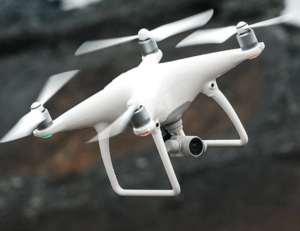
In this case, two Black Hawks of the 82nd Airborn Division were struck by an object reported to be a drone at around 8pm at night – and flying at 500 feet, above the legal limit for recreational drone flight. Some news outlets published pictures of drone parts – a broken arm and motor that apparently came from a Phantom 4 – that was actually found on the helicopter.
Finding the drone parts would seem to indicate that this is indeed the first proven incident of a drone hitting a manned aircraft. (The helicopter sustained minor damage and landed unharmed, it is important to note.) In any case, the “drone mitigation” industry has been quick to take advantage of the publicity.
Saying that the “pace of incidents is accelerating” and quoting Australian Senator O’Sullivan as saying that drones represent a “catastrophe waiting to happen” drone mitigation firm DroneShield says they are “leading the charge, together with proactive civil infrastructure and market leaders.”
The company points out that airports typically halt all traffic when a drone is “identified” – usually by visual observation – in the airspace, costing hundreds of thousands of dollars. DroneShield provides identification and neutralization strategies.
“DroneShield’s DroneSentinel drone detection system provides early warning of an incoming drone, including the location of the drone and the pilot. The system includes passive radiofrequency, as well as radar, acoustic, thermal and optical sensors,” says the company. “DroneSentinel can be optionally combined with a jammer (in the DroneSentry product) to neutralise the incoming drone threat, following the detection. Additionally, DroneShield’s DroneGun is capable of mobile deployment to intercept rogue drones, as a tactical gun-like jammer. ”
“Because of the risk of loss of life and the costs associated with drone collisions, major airports are expected to adopt counter-drone systems,” says DroneShield. “Several discussions are presently underway between DroneShield and airport authorities.”
DroneShield positions themselves as a proactive rather than reactive solution to the problem – and it may be an approach that is best not only for airports but for the drone industry. If manned aircraft is really under threat from recreational drone operators who don’t understand the regulations, “mitigation” that involves disabling the drone before any kind of contact occurs could also mitigate some of the drama and unwanted publicity that “drone sightings” cause.
Miriam McNabb is the Editor-in-Chief of DRONELIFE and CEO of JobForDrones, a professional drone services marketplace, and a fascinated observer of the emerging drone industry and the regulatory environment for drones. Miriam has penned over 3,000 articles focused on the commercial drone space and is an international speaker and recognized figure in the industry. Miriam has a degree from the University of Chicago and over 20 years of experience in high tech sales and marketing for new technologies.
For drone industry consulting or writing, Email Miriam.
TWITTER:@spaldingbarker
Subscribe to DroneLife here.